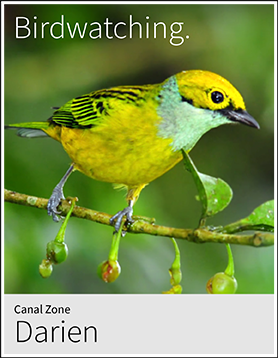Panama
Panama is situated between Colombia and Costa Rica and has a population of approx. 4 Mio. It is one of the most globalized countries in Latin America and is among the fastest growing tourism markets in Latin America. In Panama you can discover and explore an abundance of fauna and flora, white sand beaches and hundreds of islands. Panama offers much cultural diversity with its seven native Indian populations, a pleasant mix of Latin mentality and American efficiency, and the Panamanians command of English which makes traveling easy and fun.
The Panama Canal is both an engineering marvel and one of the most significant waterways on earth. It stretching 50 miles (80 km) from Panama City on the Pacific coast to Colon on the Caribbean coast and provides passage for over 12,000 oceangoing vessels and Panama Canal cruises per year. Seeing a huge ship nudge its way through the narrow Canal, with vast tracts of virgin jungle on both sides, is an unforgettable experience.
The Casco Viejo of Panama, or Casco Antiguo or Panama Viejo as some also refer to it, is the historic center and a hip and elegant part of Panama City where magnificent Colonial buildings are being restored to their original glory. Many galleries, new bars and restaurants and other commerce attract not only tourists, but locals alike. From the walkway around the monument, travelers have a nice view of the Amador Causeway and the Panama Canal, the Bridge of Americas and the skyscrapers of Panama City.
The archipelago of Bocas del Toro in Panama is situated on the northwestern coast of Panama in and around the Lagoon of Chiriqui. Bocas del Toro offers the perfect combination of Caribbean charm, nature and history with cultural traditions. Due to its variety of aquatic species, coral reefs, mangroves, tropical forest, beaches with crystal clear water and undisturbed jungles the main attractions are snorkeling, diving, hiking and bird watching. The main town is called Bocas del Toro or "Bocas Town" and is located on Colon Island, the largest island of the archipelago.
The islands of the San Blas Archipelago are strung out along the Caribbean coast of Panama from the Golfo de San Blas nearly all the way to the Colombian border. San Blas is a series of 378 islands of which only 49 are inhabited by the fiercely independent Kuna Indians. The economy of the islands is based on coconut sales, fishing and tourism, and they offer travelers good snorkeling and swimming. Facilities are few and simple, as is the food.
Tucked away in the mountains of Chiriqui and on the eastern slopes of Volcan Baru lays the small and charming mountain village of Boquete Panama. Known to produce some of the sweetest oranges and richest coffees in all of Panama, Boquete is quickly becoming a destination for travelers and retired folks alike. Boquete's surrounding hills and slopes are primarily covered in shade-grown coffee plantations, providing a rich product recognized by international connoisseurs.
Approximately a two hour's drive west of Panama City along the Pacific Coast, you will find the several miles of beaches referred to as Playa Blanca and the village of Farallon. Visitors to Panama have a nice choice of lodging options, from smart all-inclusive resorts such as the Playa Blanca Resort, or the deluxe beach community of Buenaventura. Playa Blanca beach is easily reached from the Panamericana Highway after passing smaller destinations and beaches such as Coronado, San Carlos and Santa Clara.

